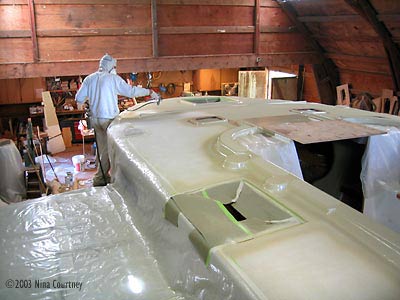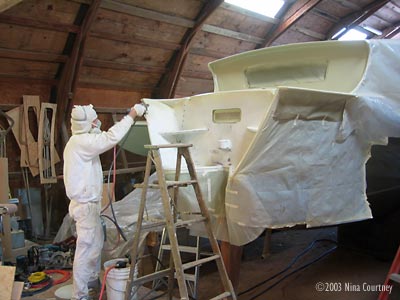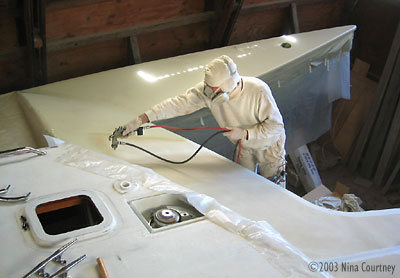
|
Here I'm spraying the finish LPU over the nonskid Griptex® on the aft cabin top. We've applied the beads in a freshly rolled-on coat of LPU and left it to cure overnight. Then I vacuumed up the loose beads, cleaned them through our fine-mesh Japanese strainer to reuse. We also used this sifter to apply the beads. Gentle tapping dispensed the beads evenly with enough volume to get a good layer.
Taping and masking takes a lot of time, but careful attention to this part of the process makes for an attractive result. One of the trickiest parts was figuring out which areas to paint first so I wouldn't walking on fresh paint or having to reach too far for proper application of the paint. |
||||||||||||
 |
||||||||||||
|
The hulls are all wrapped in protective plastic. I'm spraying the LPU on the transom and stern.
We used three different grades of Griptex®– coarse on the bow decks and foils, coarse mixed with fine for the flatter areas of deck, and fine for the cockpit seats. The finest Griptex® had to be sprinkled on through two layers of pantyhose in order to get nice even coverage. We like how the beads absorb the paint and become part of the paint layer so when wear happens, it doesn't rub paint off to reveal a speckled sand look. |
 |
|||||||||||
|
|
||||||||||||
 |
||||||||||||
| The day we were ready to paint the weather began to really heat up! The upper limit of the working temperature for this product is 100 degrees F. Well, it was 103 degrees at deck level in the afternoon, so we had to call it quits and wait. We were out at midnight with the quartz lamp rolling the last coat over the nonskid areas.
I am really warm here in my paint garb. My latex gloves kept filling with sweat and dripping onto the freshly painted surface. Luckily it beaded up and didn't cause a problem. We are happy with the result and the color– we matched "Lion" from Behr, a very dull but pale green. This shot also has a fairly good view of the windlass deck box in the foreground. |
||||||||||||
This site, copy and photographs copyright Nina Courtney.